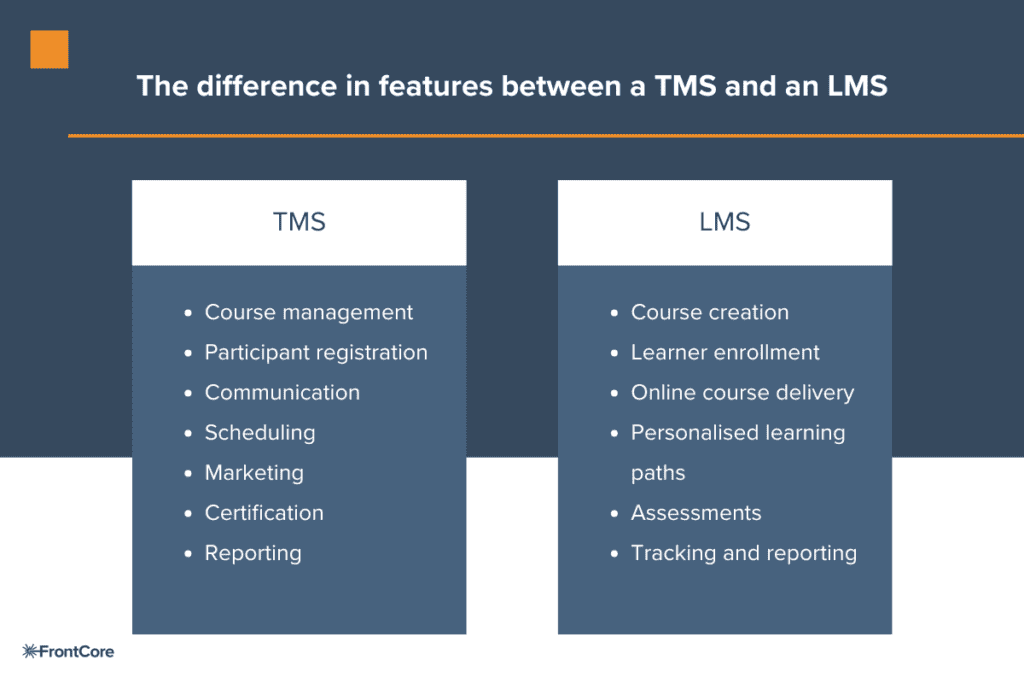Training management system vs. Learning management system

Navigating the world of training and learning management, or in general the training technology universe, can sometimes feel like moving through a jungle of acronyms and word jumbles. For that reason, we want to highlight the two main training systems, namely the Training Management System (TMS) and the Learning Management System (LMS), and neatly explain the main differences between them, but also how they serve purposes that sometimes go hand-in-hand in the learning ecosystem.
TMS vs. LMS: What is the difference between them?
The TMS is designed to handle the operational and administrative side of instructor-led training and virtual instructor-led training, otherwise known as in-person training and online training. It functions as a back office tool for training administration and the logistics of organising training programmes.
The LMS is focused on learning and delivering the necessary content to learners so that they can achieve their learning objectives. It is a front office software that is designed to create, deliver, and track e-learning courses. For training providers, it is central to content management, learner engagement, and performance tracking.
What is training management?
Training management refers to directing and organising back-end training activities. You can be oriented towards instructor-led training (ILT), virtual instructor-led training (vILT), or a combination of both in-person and online training sessions.
Training management covers all aspects of administration related to training, and it is often connected to a software solution, like a training management system (TMS), which organises all the following activities in one online platform:
- Scheduling
- Logistics
- Resource management
- Team
- Costs
- Sales & marketing
- Reporting
- Booking
- Participant management
What is learning management?
Learning management refers to the processes, tools, and strategies that training providers use to achieve certain learning objectives. There is a distinct focus on providing assets that learners need to be successful and achieve their learning objectives. One of the tools that training providers have in their toolkit to achieve this is a learning management system (LMS), which is a software solution for delivering learning content. It is essential that the content is tailored to the theme or learners, including the relevant format, design, and presentation.
What is TMS?
TMS, a training management system, is a software solution that aims to optimise back-office training processes. Training providers use a training management system to manage, track, and sell training. Additionally, there is an underlying focus on optimising administrative processes when using the TMS in training companies. The end goal is to equip training providers with efficient tools to scale their business. The TMS allows for that through its features and functionalities.
Streamline your processes
Our Training Management System enables you to grow your business profitably and efficiently by automating administrative processes and simplifying everyday tasks.
What is LMS?
The LMS (learning management system) is a learning software that enables anyone to deliver and manage e-learning courses. As a training or learning provider, you can use it as an efficient tool to deliver online video content and create interactive online lessons for learning. The key element of an LMS is that these lessons are accessible at any time, catering to a wide range of learning preferences.
Offer more engaging online courses
Build engaging courses and elevate your e-learning game through customised learning sessions and targeted online course modules in our Learning Management System.
Features in TMS
A TMS covers all the logistical elements of learning, from managing live instructor-led courses or seminars to performance reporting and invoicing.
List of features in a TMS
- Course management
- Training management
- Participant management
- Corporate customer management
- Online course catalogue
- Online registration
- Corporate booking
- Scheduling
- Instructor onboarding
- Email and communication tools
- Finance and payment
- Marketing
- Sales
- Routine automation
- Check lists
- Assessment and evaluation
- Reporting
- Diplomas and certificates
Features in LMS
An LMS is primarily a software that supports e-learning courses. It is a place where you gather your catalogue of online on-demand courses, where participants can pick and choose course programmes and sign up for relevant courses. They sign up and complete the courses in the software whenever and wherever they want. The most important feature of any LMS is the ability to provide high-quality course materials through customisable training modules. You also want to communicate with your participants through the software and do learner performance tracking.
List of features in an LMS
- Course creation and content management
- Learner enrollment
- Online course delivery
- AI course tools
- Video training tools
- Content editor tools
- Assessments and learning progression
- Learner engagement
- Tracking and reporting
- Compliance and certification management
- Mobile learning
- Integration
- Personalised learning paths
What is the difference in features?
Situation: When do I need a system for training management?
A training team, either internal or external, uses a TMS. The training team can consist of a Chief Learning Officer (CLO), training director or manager, training administrators and training specialists, depending on the situation where the TMS is being used.
The following list name all the relevant people that use a TMS:
- Learning and Development departments
- Learning providers
- Commercial training providers
- Managed learning services
- Corporate academies
- Universities and higher education institutions
- Nonprofit organizations
When to choose a TMS
- If you want to eliminate administrative costs and time constraints
- If you are working in or for a company in the training, learning, education, healthcare, or professional development industry
- If you are a training provider who offers in-person learning, online training, e-learning, or blended learning courses
Situation: When do I need a system for learning management?
An LMS is used by both training providers and learners. Training providers use the LMS to create, manage, and publish e-learning courses, while learners access these courses through the LMS to complete their training online. In organizations that also use a TMS, the TMS is used to manage e-learning courses in the same structured way as in-person training – handling scheduling, participant administration, and communication. The LMS then delivers the actual e-learning content to the learners. For example, a commercial training provider or a supervisor in an internal training department might plan and coordinate e-learning in the TMS, and use the LMS to deliver the learning content and track learner activity and progress.
When to choose an LMS
- If you are an internal training provider: Historically it has been more popular with internal training providers because of the modular design of the software, making it easy for learning and development departments to organise customisable training sessions for their colleagues.
- If you are an external training provider: More and more external training providers offer e-learning, which the LMS is ideally suited for. This also opens up for offering blended learning sessions.
Do I need both?
Whether you need both TMS and LMS depends on several factors, including how many of your courses are organised in-person and how many are being held online in an e-learning format. If they are all led by instructors, there is much more administrative work, which speaks in favour of the TMS. If you have a large amount of online courses that you offer, then an LMS would be beneficial in order to create the necessary engaging content and structure you need. To sum it up, it depends on the purpose of the software, which relates to your business model and goals, as well as the clientele of learners to whom your business model caters.
You may benefit from having both TMS and LMS
- If you are a large training provider with an organisational structure that requires it
- If you want to scale your business and transition to use TMS as well as LMS
- If you have a LMS and want to integrate it with a TMS, or vice versa
- If you are a small training provider or corporate training department who offer e-learning
Scale your business with a TMS
If you’re looking to scale your training business, a Training Management System (TMS) is your best ally. With powerful automation and reporting capabilities, a TMS helps you save valuable time and provides the insights needed to boost your return on investment (ROI).
For training providers, the TMS takes over repetitive and time-consuming administrative tasks, freeing up resources to focus on growth. It also delivers essential data on course profitability, collects learner feedback, and uncovers opportunities to improve customer satisfaction and retention. These insights not only help enhance your current course offering but also guide smarter decisions for attracting future customers.
While many in-house training departments don’t use a TMS, those that do benefit from more efficient training operations. A TMS helps centralise scheduling, registration, and communication, making it easier to coordinate internal sessions across teams. It also supports consistent training delivery and simplifies compliance tracking – especially useful for mandatory programs. The result is less manual work, better organization, and more time to focus on improving internal training quality.
Highlight the time and cost savings associated the TMS
Are you challenged by internal disagreements on whether the TMS is worth the investment? Convince your team to get a TMS by highlighting the benefits and addressing the challenges. You can reduce administrative tasks and save time on manual reporting if you use a TMS. As we all know, time is money, and by saving administrative time, you can reallocate time to more strategic tasks like improving training content or expanding the course catalogue. If you have a realistic, data-driven approach to the benefits and possibilities of using the software in your business or department, you are one step closer to convincing stakeholders that the TMS is worth the investment.
The FrontCore TMS
There are many tasks to keep track of as a course provider. To streamline these responsibilities, you should use training management software that allows for easier course administration. A training management system will make all administrative tasks associated with your course catalogue much easier. Explore our customer success stories to get a better understanding of how we have helped other businesses like yours.
The FrontCore Training Management System is a one-stop solution for course administration, something commercial training businesses like yours will benefit from. We also offer marketing and sales modules within the software so that you can boost engagement around course from one place.
Did you like this article? Don't forget to share it:
About FrontCore
Over 3700 training providers use solutions from FrontCore – and that’s not without reason. FrontCore is one of Norway’s leading competence environments within cloud based systems for Training Management, Learning Management and Webmarketing. With over 23 years of experience from the training industry and our finger on the market pulse continuously, we help course and training providers achieve more efficiency and higher revenue.
Products

Related articles
The value of a well-considered coaching conversation [The Five C’s]
We believe that coaching conversations should generate real value for people being coached, both on an individual and an organisational level. By drawing on their own experiences, a coach can guide a coachee towards greater commitment, confidence, and control, among...
What makes a good trainer?
What does it take to be a truly great trainer? We reveal the 7 essential qualities every instructor needs, from empathy to strategic thinking, to create powerful learning experiences and build a thriving training business. Read now and level up your game.
Guide: Learning theories for adult education
Effective adult learning starts with understanding how adults think, work and grow. This guide breaks down key learning theories and shows how training providers can create relevant, goal-driven experiences that meet the needs of today’s adult learners.




![The value of a well-considered coaching conversation [The Five C’s]](https://frontcore.com/wp-content/uploads/2025/09/coaching-conversations_frontcore-400x250.jpg)


0 Comments